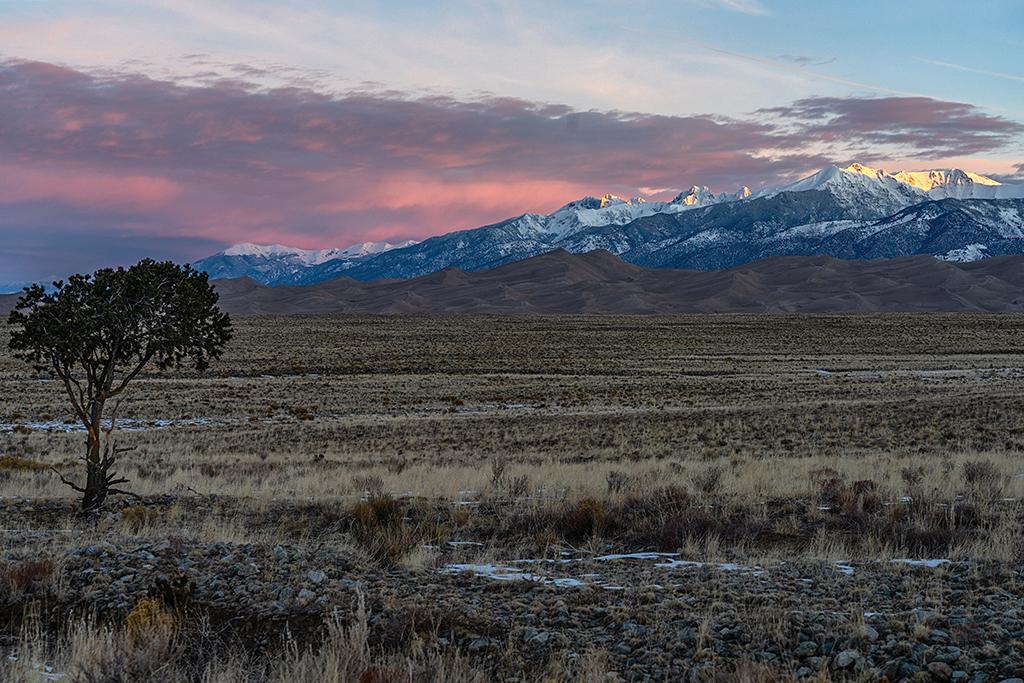
A national park and preserve filled with superlatives and contradictions, Great Sand Dunes National Park and Preserve / Rebecca Latson
Picture-perfect Great Sand Dunes National Park and Preserve in Colorado is filled with contradictions and superlatives: the tallest sand dunes in North America surrounded on three sides by the broad, windswept, San Luis Valley, and a backside firmly snuggled against almost 42,000 acres of the rugged, snowcapped Sangre de Cristo Mountains. If you are experiencing winter doldrums or photographic cabin fever, then a visit to this national park might just cure both maladies, as it did mine when I traveled to Great Sand Dunes this past February 2024.
Winter at Great Sand Dunes means no crowds, plenty of space, and solitude in abundance. The other side of the coin, though, is that the almost constant breeze enhances the season’s chill, and you might encounter restricted access to some areas due to the snow, making a forest/alpine hike even more labor-intensive … if you can find the trailhead. No matter. This national park and preserve offers enough wonderful photo ops to belay the need for boondocking over a snow-blanketed dirt & gravel road.
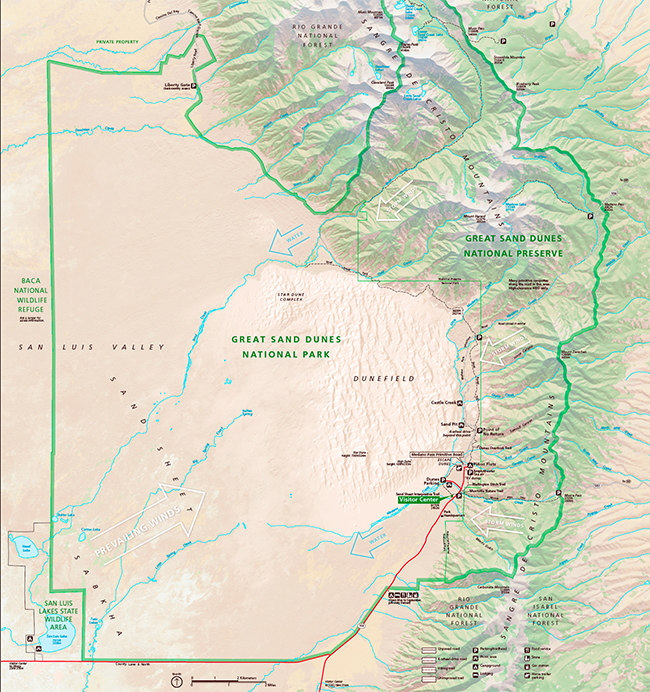
Map of Great Sand Dunes National Park and Preserve / NPS file
I chose not to spend the two days it would take driving to this national park, opting instead to fly into Denver, Colorado, then rent a car for the four-hour drive south and west to both the park and my Alamosa lodging. Like my road trip through the Canadian Rockies, I knew weather might be a mixed bag. Luckily, my February days spent in that portion of the state were bright, sunny, clear, and quite cold, occasionally punctuated with cotton candy clouds.
Many, if not most, photographers lament bluebird days, but I appreciated those pristine skies accentuating the toothy mountains and velvety-curving dunes. The clear, mostly unobstructed sunlight produced beautiful sunrise, sunset, and blue hour compositions.
While there are forested/alpine trails into the backcountry, most of them will be buried beneath ice and snow this time of year. So, the big draw is the trail-less 30-mile dunefield “sandbox,” in addition to the many spots just off the side of the road where you can see and photograph different perspectives of those dunes, mountains, and overall area geology.
Perspective is the key word to winter photography in this national park and there are many different perspectives from which to capture those shots. If you head toward Great Sand Dunes from either Mosca or Alamosa, you’ll be viewing the park in a northerly-facing direction. Depending upon where you place your tripod, you might not only capture nice sunrises, but sunsets from the same spot, as well.
Note: I am always cognizant of keeping horizon levels straight, so as you look at these images and notice a slight tilt to the landscape floor, it’s not because I was negligent. There is, indeed, a dip to the terrain.
There’s a pullout at the intersection of Colorado State Highway 150 (toward the park) and Lane 6 N (toward Mosca). This stop provides a wonderful view of the entire dunefield, background mountains, and the valley portion known as the “sand sheet.” From here, I captured wide-angle and telephoto shots from early morning into early evening.
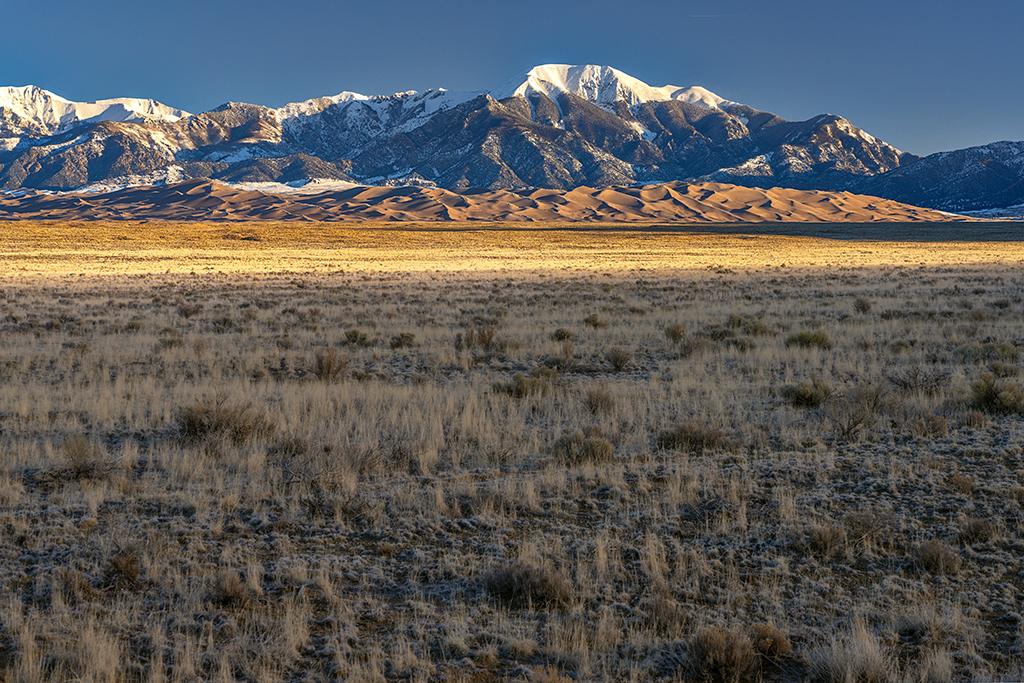
Morning light over the landscape, Great Sand Dunes National Park and Preserve / Rebecca Latson
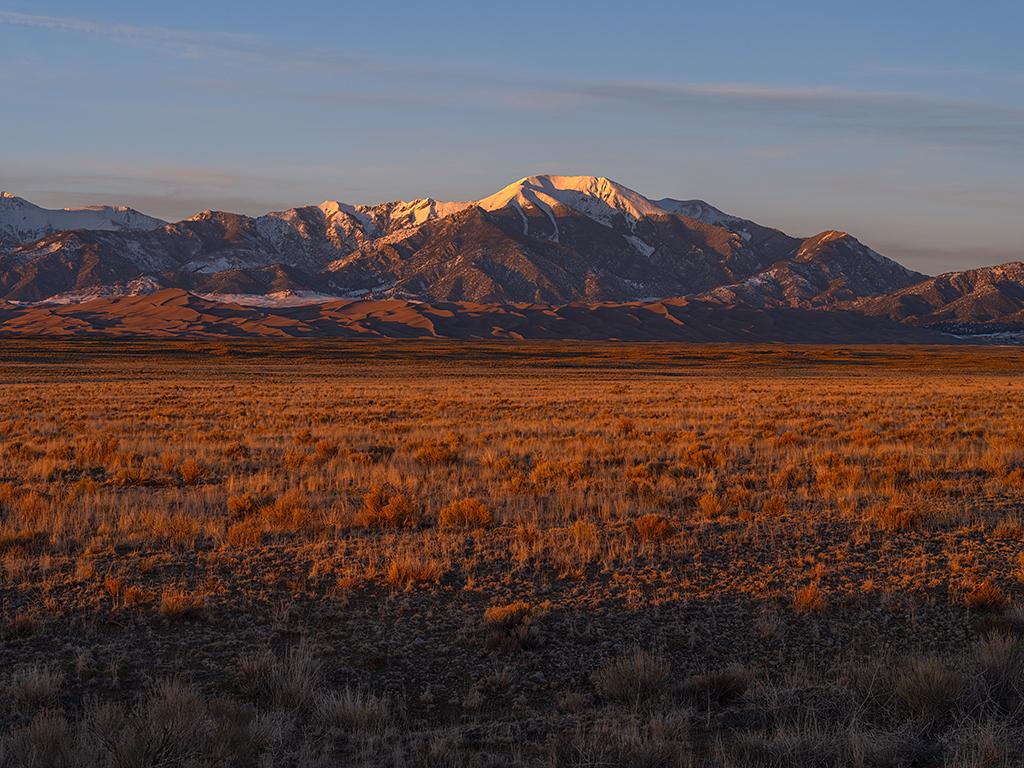
Sunset's golden light over the park, Great Sand Dunes National Park and Preserve / Rebecca Latson
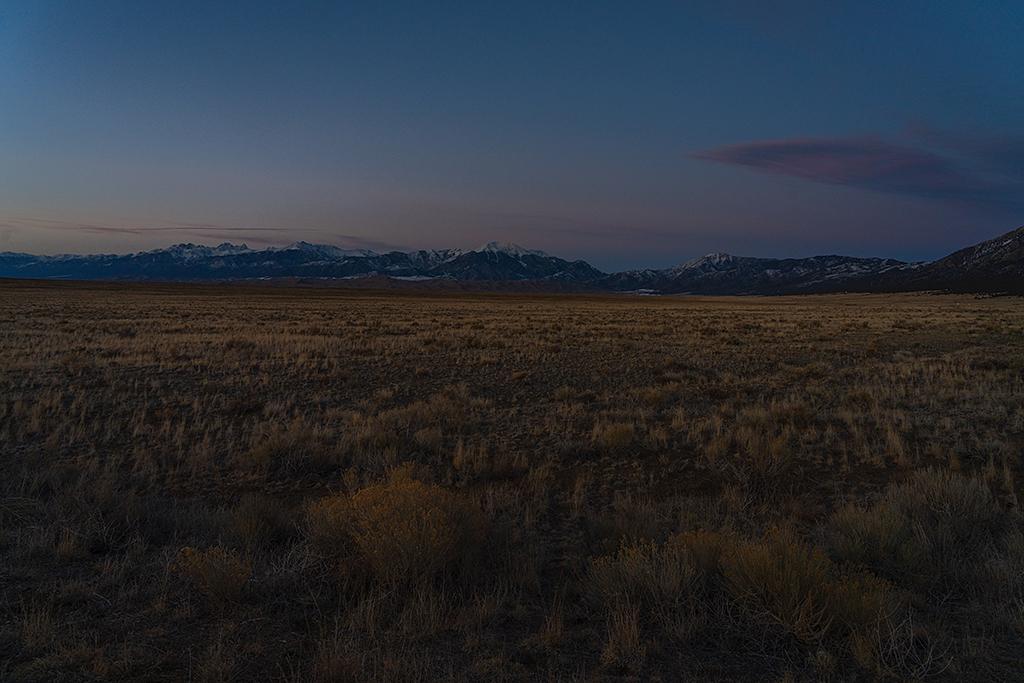
The beginning of blue hour over the park, Great Sand Dunes National Park and Preserve / Rebecca Latson
Stop at the pullouts before and after the park’s entrance booth to read the informational signs and capture shots of the landscape. Call on the park’s visitor center, wander the exhibits, then step out the back of the building for yet another perspective of both dunescape and mountains. Arrive there prior to sunrise on a clear morning and you’ll be in time to capture sunlight gracing the mountain peaks, perhaps viewing a sight much like that witnessed in 1719 by Spanish explorer Antonio Valverde y Cosio, who (according to Britannica.com), when beholding a red-tinted sunrise on the snowcapped peaks, “supposedly uttered a fervent ‘Sangre de Cristo’ (‘Blood of Christ’).”
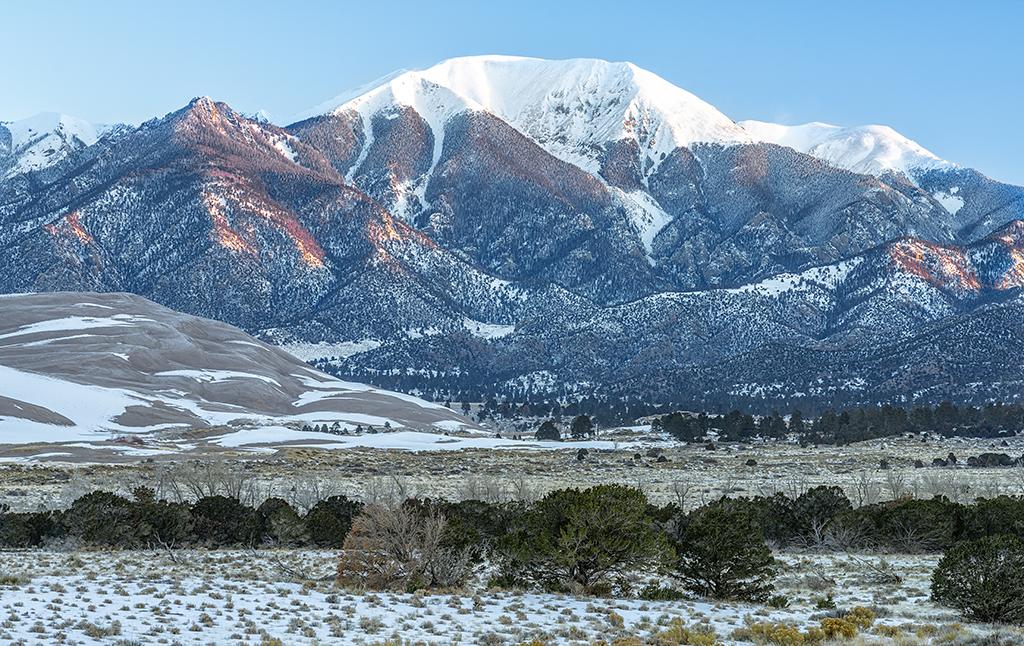
Sunrise light over the Sangre de Cristo Mountains as seen from behind the Visitor Center, Great Sand Dunes National Park and Preserve / Rebecca Latson
During my February visit, sunrise crept above the horizon between 7:20 – 7:30 a.m. Sunset occurred between 5:35 – 5:38 p.m. Blue hour was, naturally, before sunrise and after sunset, when blue, purple, and pink bathed the winter sky and the “belt of Venus” atmospheric phenomenon faintly colored the low horizon.
If your interest runs to geology in your landscape shots, then a great location for capturing the park’s geologic system (mountain watershed, dunefield, sand sheet, and sabkha) is from the boat ramp at San Luis Lakes State Wildlife Area, a little over nine miles east of Mosca. The ramp gate is locked for the winter but you can walk around the gate to stand and photograph the landscape. Including the seasonally-shallow San Luis Lake.
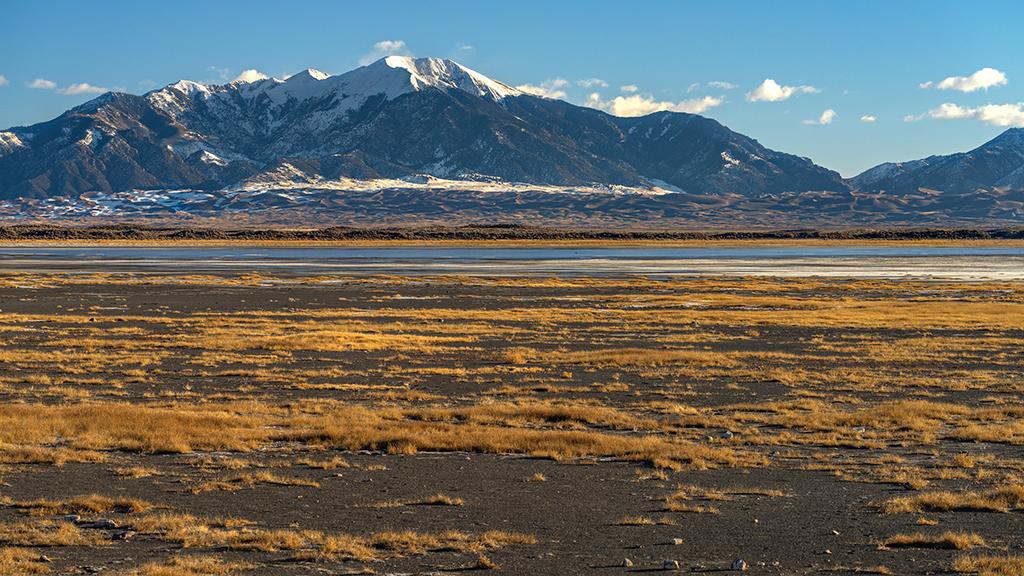
Mountain watershed, dunefield, sand sheet, and sabkha seen from San Luis Lakes State Wildlife Area near Great Sand Dunes National Park and Preserve / Rebecca Latson
They call Montana “Big Sky Country,” but Great Sand Dunes earns that moniker as well, with plenty of open sky. As such, I want to mention the term “negative space.” My February 2019 Traveler article talks about negative space, which is the area surrounding your photographic subject. If you’ve never heard the term before, click on that link. In this national park, it’s easy to photograph a lot of negative space, and the amount you include within your photo frame alters your viewer’s perception of the landscape.
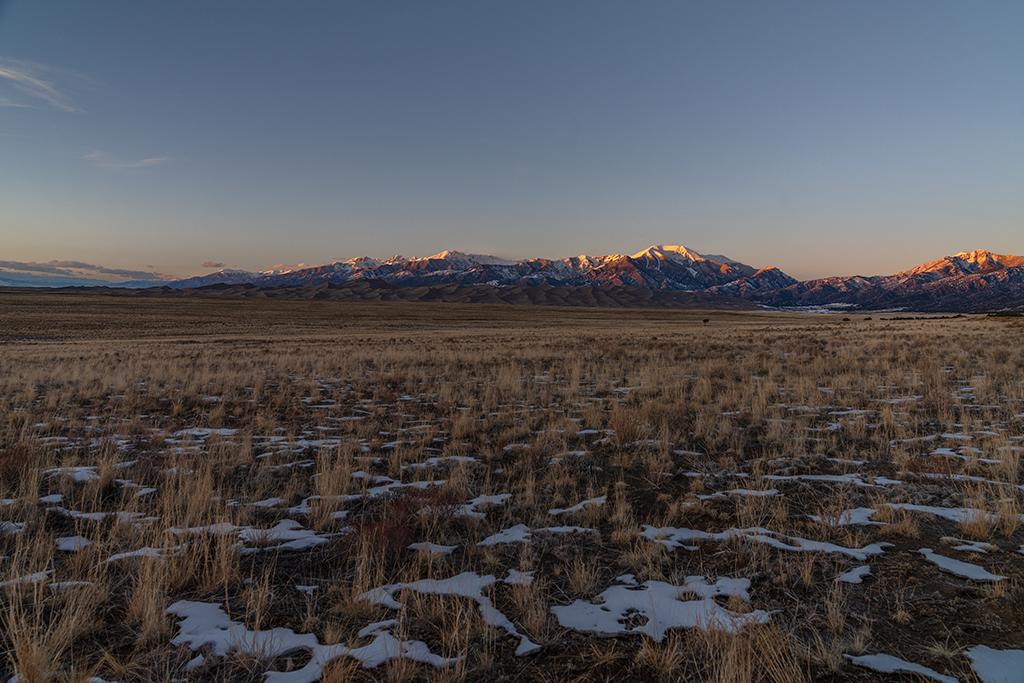
Sunset and wide-open sky (the negative space), Great Sand Dunes National Park and Preserve / Rebecca Latson
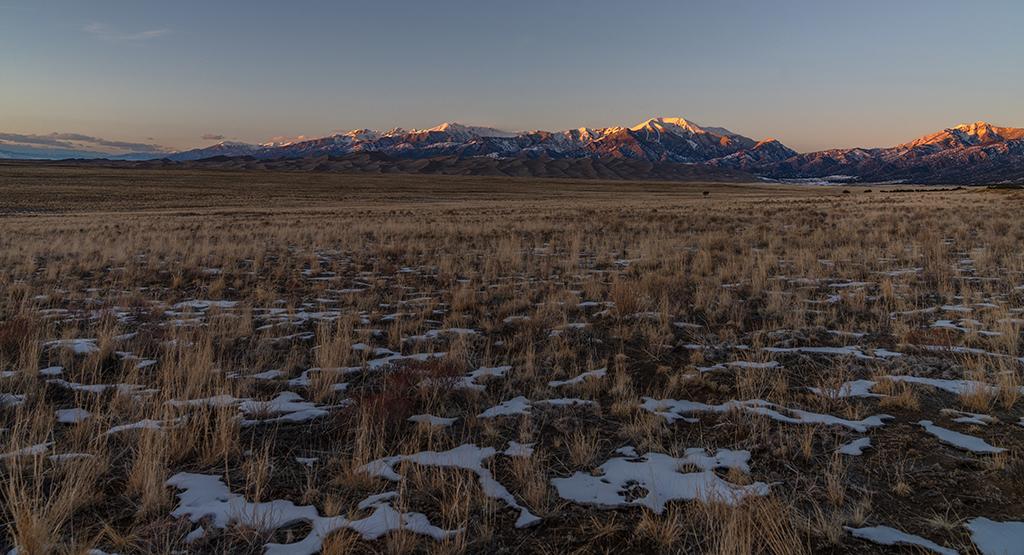
Evening sunset with a little less negative space, Great Sand Dunes National Park and Preserve / Rebecca Latson
Great Sand Dunes is the perfect park for photographing multiple images to stitch together by photo editing software for a wide panorama. You’ll want to do this on a tripod for level shots as you pan your camera from one side of the landscape to the other. If you’ve never created a panorama shot before and are using Adobe Photoshop as your editor, here’s the link to a short tutorial on stitching together images. The panorama below consists of seven shots stitched together in Photoshop.
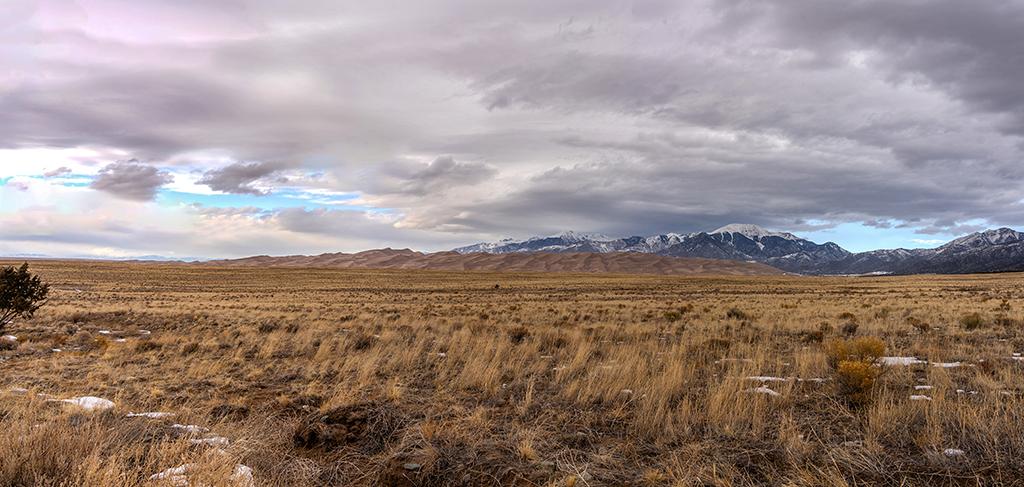
Late afternoon panorama, Great Sand Dunes National Park and Preserve / Rebecca Latson
You can also use a wide-angle lens to capture the entire landscape if you don’t feel like going to the effort of stitching shots. Cropping that wide-angle composition makes it look even more like a multiple-shot panorama, though cropping loses landscape as well as a little bit of resolution.
Of course, if you are capturing images with your smartphone, there’s an actual panorama setting and all you’ll need to do is choose that setting and tap the “shutter” to begin panning.
As you capture images of the broad dune-and-mountain landscape, keep in mind you’ll want those shots to look totally in focus, front to back. For this, it’s necessary to capture two identical shots of the same view, one focused for the foreground, and one focused for the background. During the editing stage, both images are stacked so the resulting shot is in focus. If you’ve never worked with focus stacking and are using Adobe Photoshop as your editor, here’s a link to a tutorial for focus stacking images. There are also software plug-ins for focus stacking, such as Helicon Focus, Luminar NEO, and ON1, and Zerene Stacker. Smartphone users may achieve good results by doing nothing more than aiming your phone’s camera at a scene and tapping the shutter button.
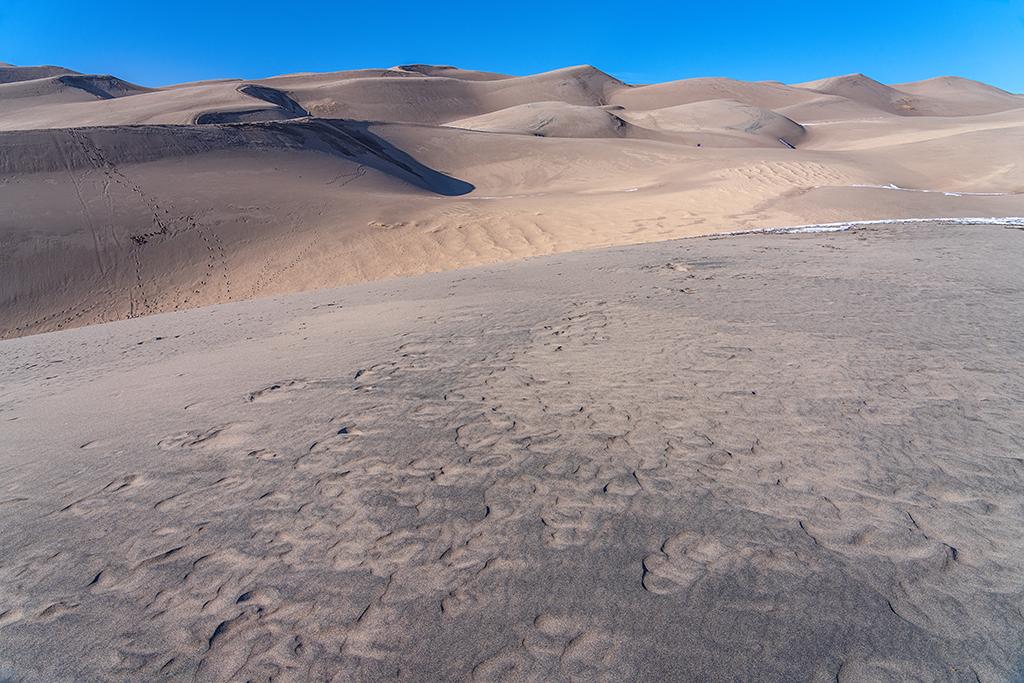
Sand dune landscape focused front to back, Great Sand Dunes National Park and Preserve / Rebecca Latson
Designated an International Dark Sky Park in 2019, Great Sand Dunes’ night skies are unimpeded by light pollution from local communities. Unfortunately for me, clouds impeded a starry view on the one night I stayed up late enough for a little nighttime photography. This end-of-night-beginning-of-morning view in the image below at least gives you some idea of the vast spaces you can set up your tripod for some night sky shots of your own.
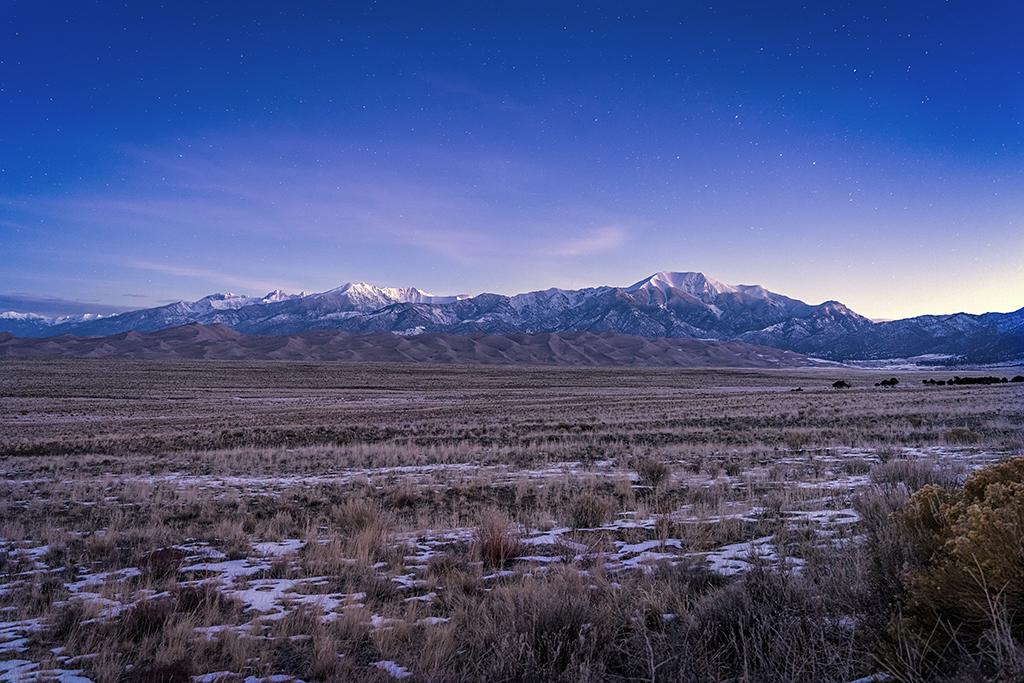
The end of night and beginning of sunrise, Great Sand Dunes National Park and Preserve / Rebecca Latson
In addition to wide-angle views, capture a few landscapes using your long lens. Telephoto images underscore the undulating light, shadows, and curves of these magnificent dunes.
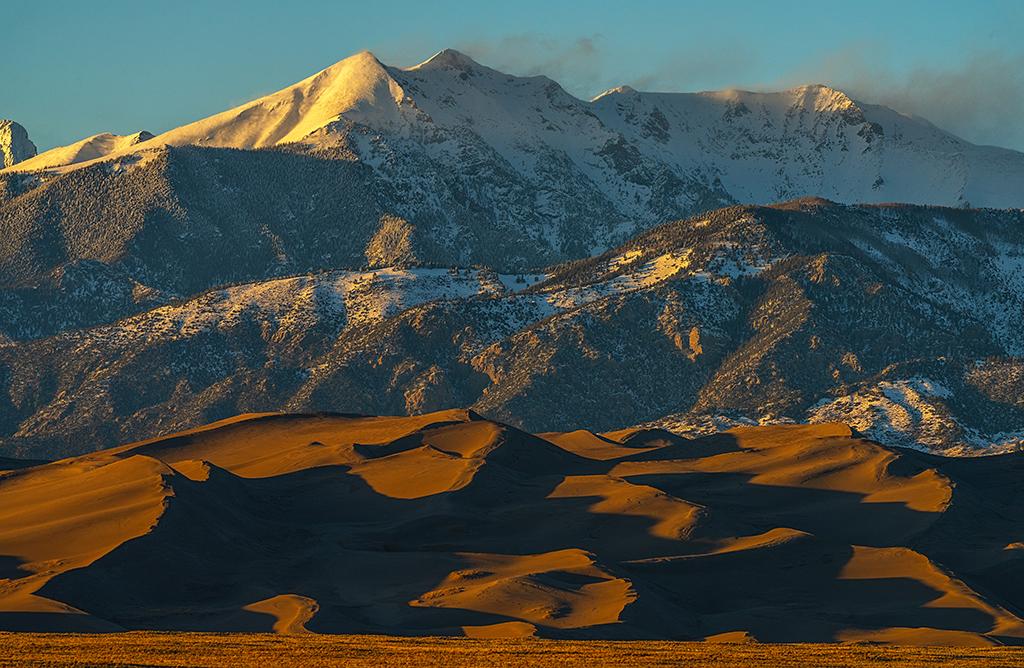
A telephoto sunset over mountains and dunes, Great Sand Dunes National Park and Preserve / Rebecca Latson
Don’t forget to add people to some of your imagery. Get them having fun sliding/running down the dunes or just standing still to take in the view. These specks of humanity against the sand provide excellent scale to the immense dunes in the background.
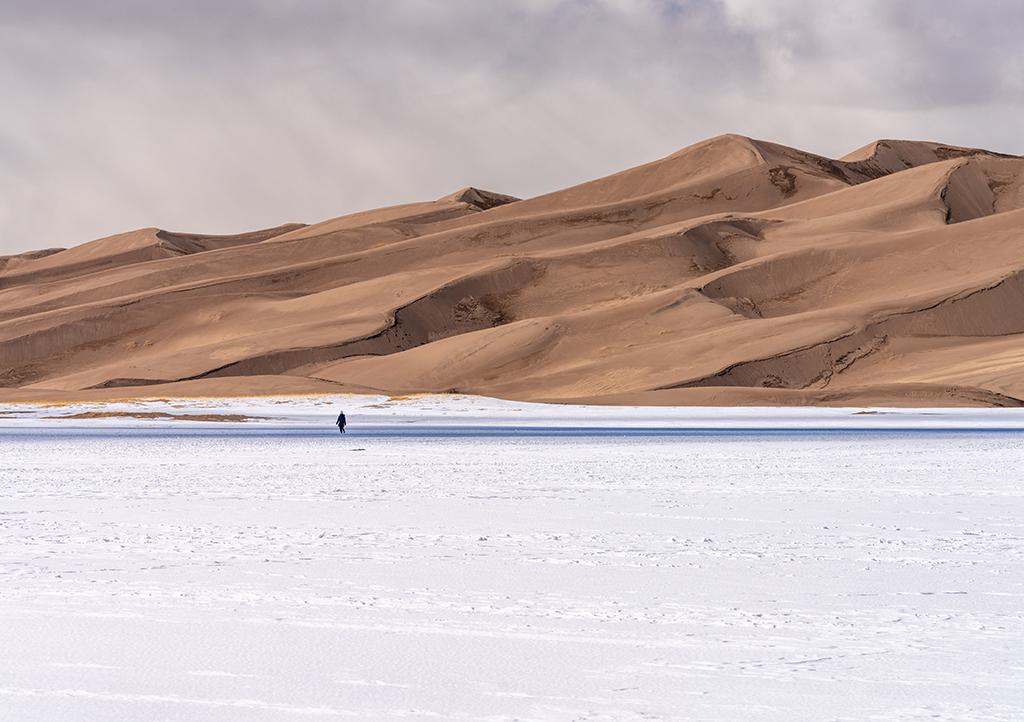
Human scale and reference for the dunefield, Great Sand Dunes National Park and Preserve / Rebecca Latson
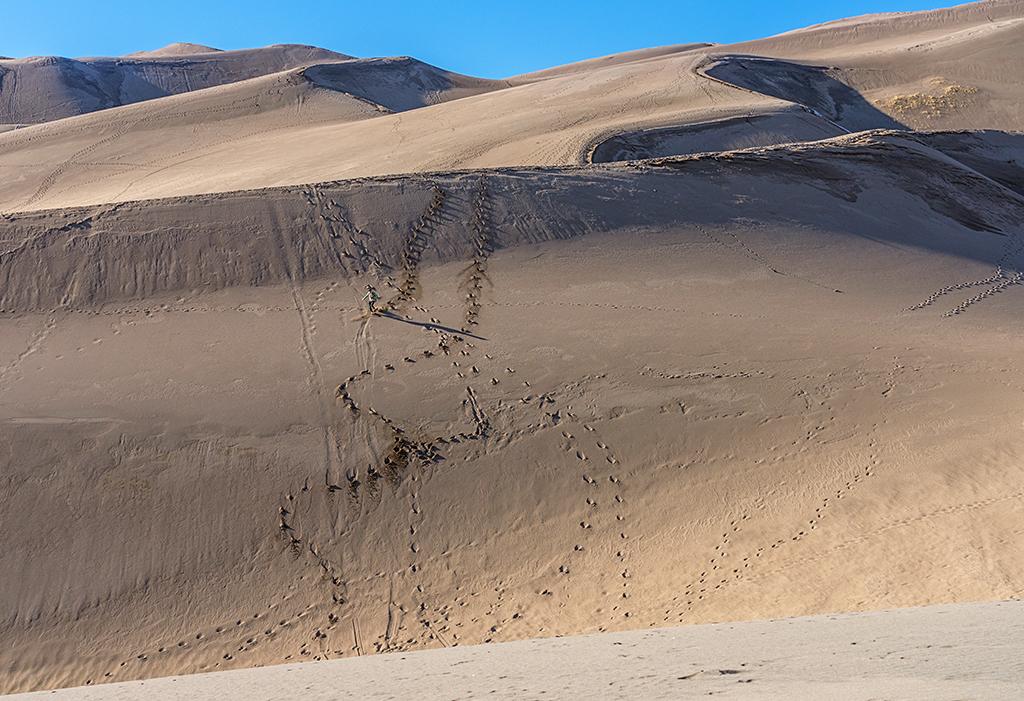
Full tilt down dune, Great Sand Dunes National Park and Preserve / Rebecca Latson
You may or may not see much wildlife during the winter. I saw a small group of elk, all of which (except for the one, here) picked up and left when they saw me bring out my long lens. Sigh.
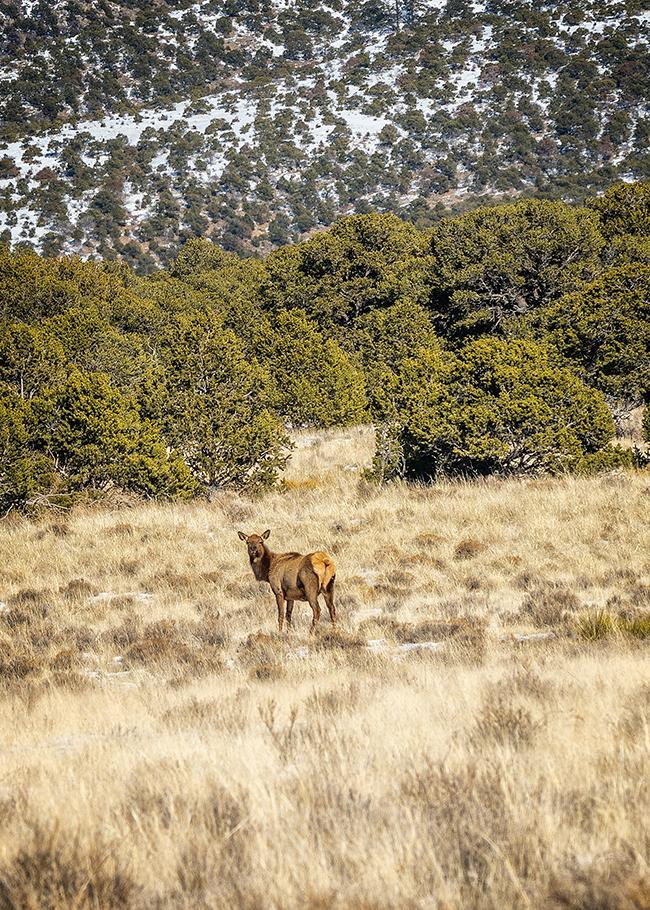
Staying still long enough for a look-see, Great Sand Dunes National Park and Preserve / Rebecca Latson
As you wander the park through the harsh light of midday, don’t put your camera away. Believe it or not, harsh light can work to your advantage in this national park. While sunrise or sunset shadows add depth to the dune landscape, the lack thereof during midday allows you to see and compare the dichotomy of sharp, rugged, blue-and-white mountain landscape versus the neutral color palette and soft textures of the sand dunes. Besides, you may only be in the park, or in that spot, during the noon-ish hours. Make do with the light given and you’ll surprise yourself with great results.
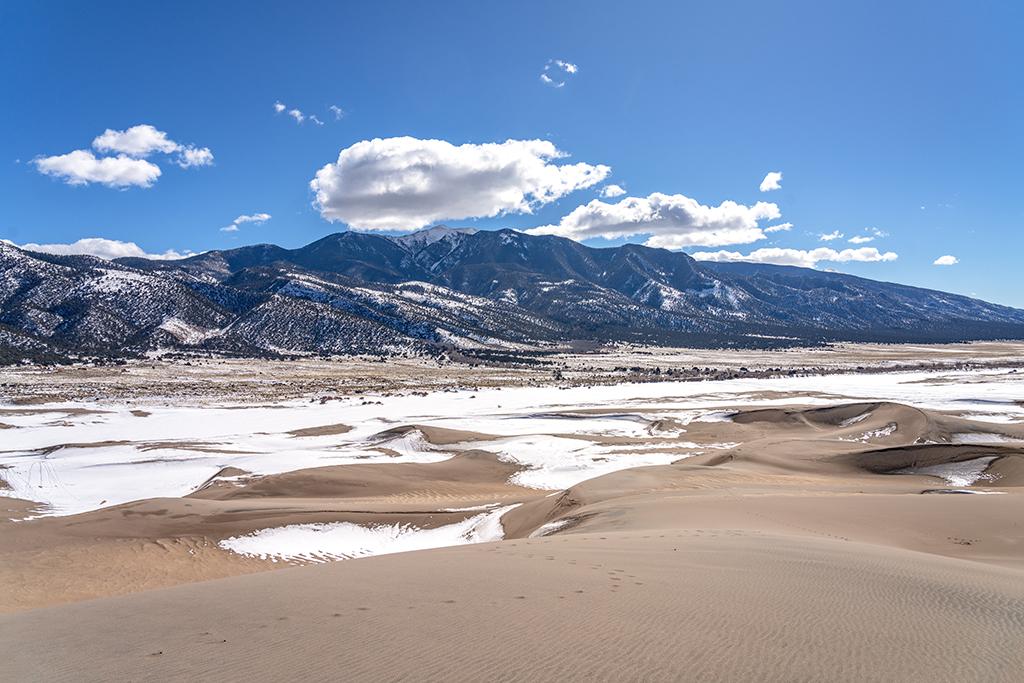
A noontime look at the landscape, Great Sand Dunes National Park and Preserve / Rebecca Latson
Experiment with some of your images by converting them monochrome. I’ve always believed black-and-white treatment enhances textural differences and highlights those nuances between light and shadow. Great Sand Dunes is an excellent venue for this sort of photography. Just take an original color shot, make a copy of it, then use your photo editor or plug-in to create a monochrome composition.
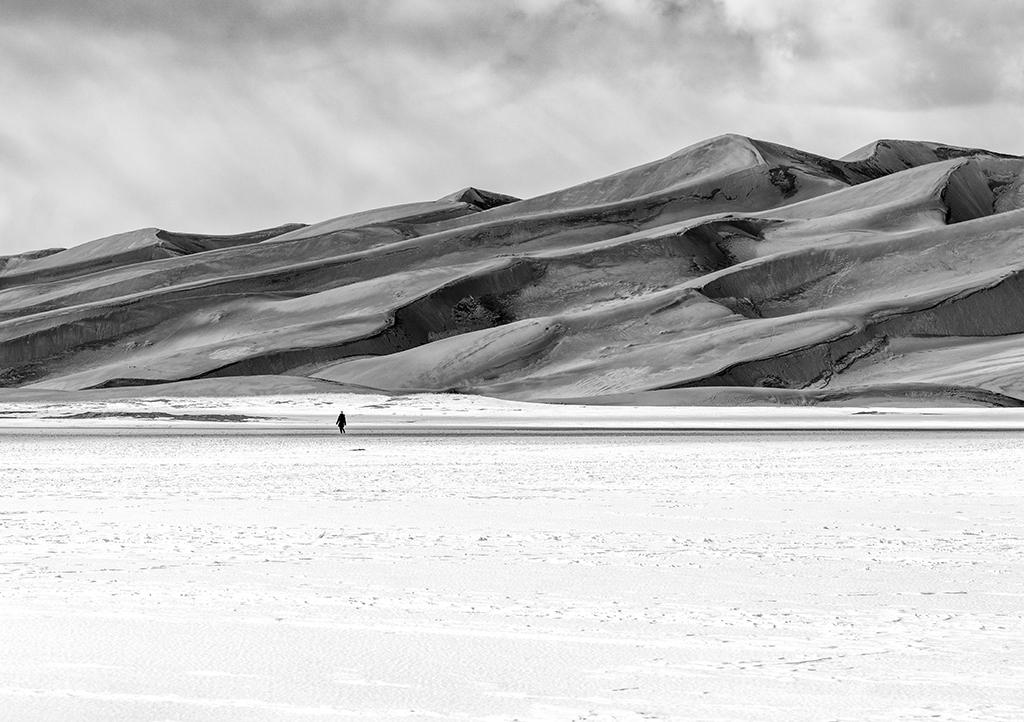
Human scale and reference in monochrome, Great Sand Dunes National Park and Pr
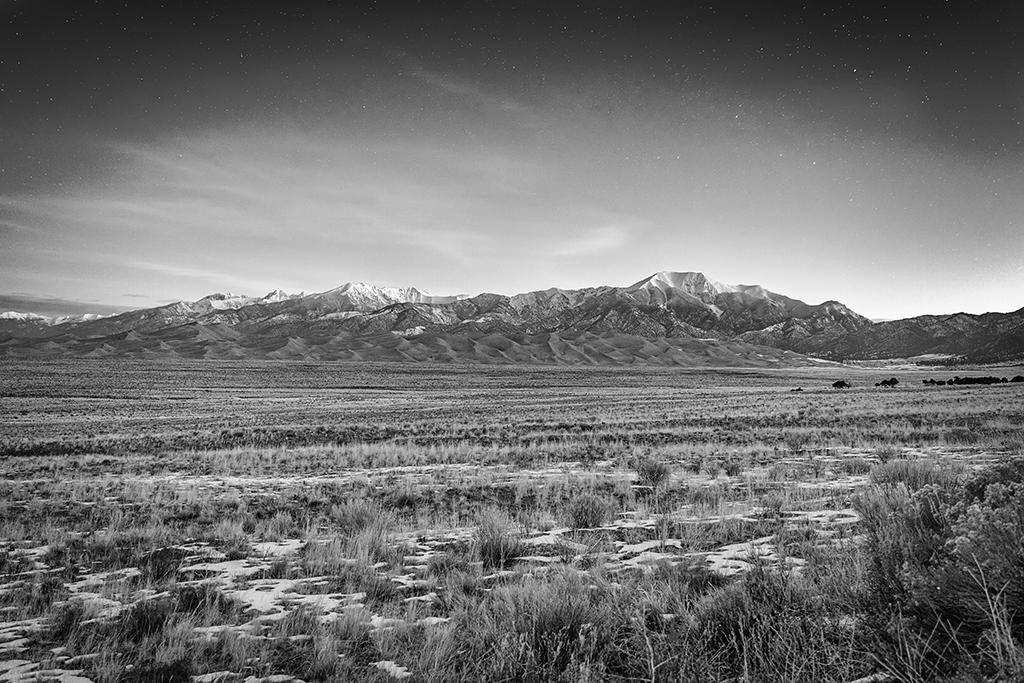
End of night and beginning of sunrise in monochrome, Great Sand Dunes National Park and Preserve / Rebecca Latson
Don’t forget to capture a leading line shot or two. Leading lines are anything moving the viewing audience’s eyes from one part of the image to another, either side-to-side or front-to-back. Roads make great leading lines, and you won’t encounter too much traffic on the park road during the winter.
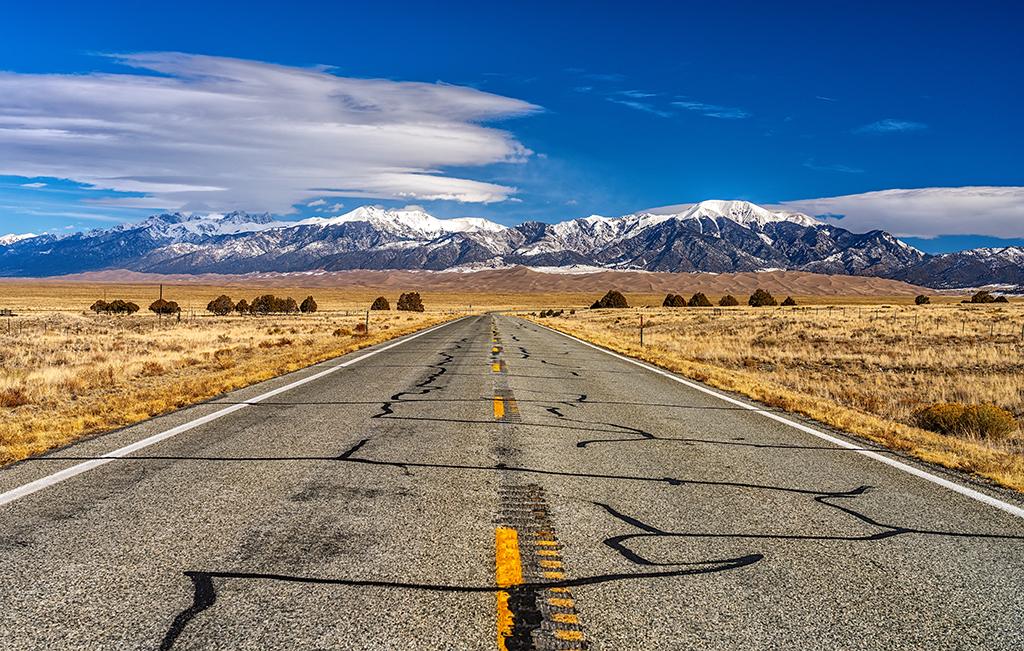
The road to Great Sand Dunes National Park and Preserve / Rebecca Latson
Capture photos of anything and everything to flesh out your park visit. While you might not see much in the way of insects or wildlife during winter, you’ll spy other interesting things, such as fluffy-looking, straw-yellow vegetation high up in the dunes, black patches of magnetite mineral grains (which you can pick up with a magnet) on the beige sand, critter paw prints heading up or down dune, and interesting formations created by wind and sand.
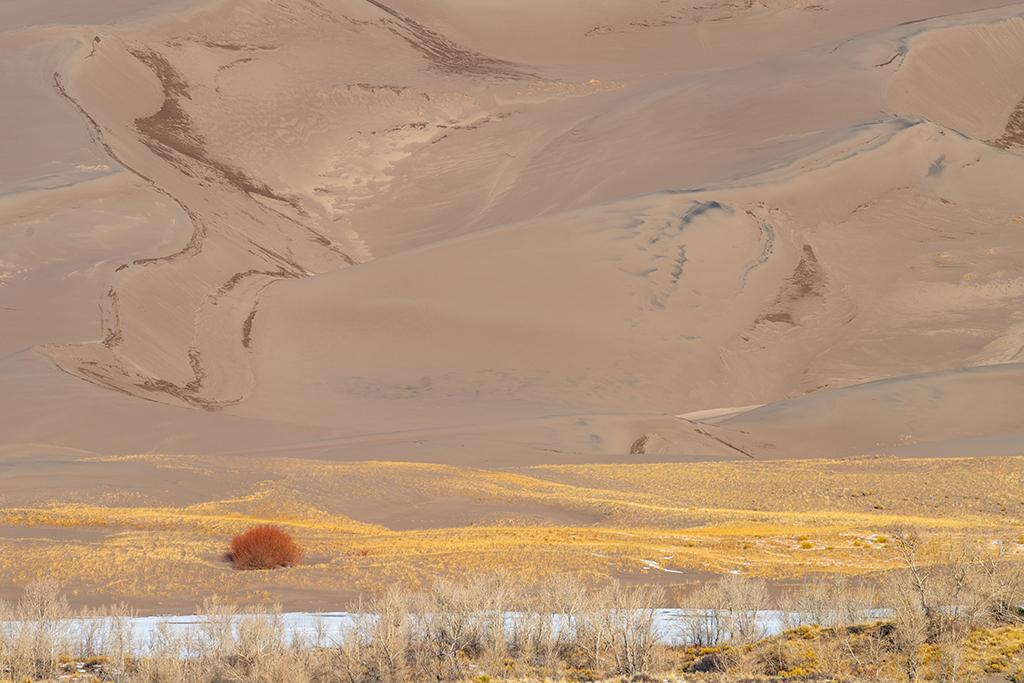
Vegetation and black patches of magnetite in the sand, Great Sand Dunes National Park and Preserve / Rebecca Latson
Film a short video or two, while you are at it. Watching sand grains sliding across the dune floor from blowing wind is mesmerizing. Pan around for a full view of the landscape. If there are nice fluffy clouds, you’ve dressed warmly, and you have enough patience for at least 20 minutes of standing in one place, then capture a timelapse, too.
You won’t be surfing Medano Creek’s surge pulse, nor hiking (with ease, anyway) the forest/alpine trails at Great Sand Dunes National Park and Preserve during winter, and it’s going to be quite cold and windy. The upside is plenty of solitude, wide open spaces, no crowds, and myriad photo ops awaiting your cameras. I guarantee the trip to this national park and preserve cures both cabin fever and winter doldrums.


